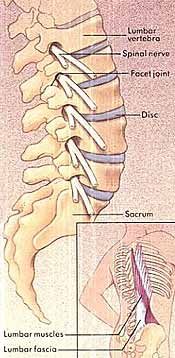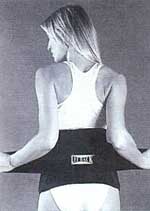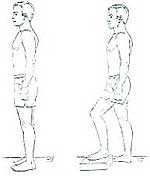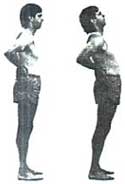Spine/Low Back
Low Back Disorders
(e.g., Low Back Pain, Lumbago, and Sciatica)
The Injury
Back pain is very common in athletes, active, and inactive people. Back pain can range from a nagging ache to a severe, incapacitating pain. The most common cause of low back pain (LBP) is misuse of the back muscles when performing unaccustomed physical activities, such as lifting heavy objects, sprinting, playing basketball, or doing yard work. Low back pain can result from problems with the structures and functioning of the back and spine. LBP can be caused by conditions unrelated to the back and spine, such as pregnancy, head injuries, and organ disease. Some of the more common causes and types of LBP in athletes include the following:
Mechanical Low Back Pain
This is the most common type of back problem seen in athletes, accounting for 70 – 75 percent of the total. It is caused by strain from microscopic to larger tears in the ligaments of the spine, leading to stiffness, loss of mobility, and pain. Despite the problems caused by strain and sprain, these injuries are the easiest to treat.
Facet Joint Syndrome
The vertebrae in the lower back (lumbar spine) are connected by small joints (facet joints). Unusual to extreme forces on the lumbar spine, as with excessive twisting or arching of the back, can sprain these joints, causing them to become inflamed. Use of the back after such an injury will cause constant irritation of these inflamed joints, leading to persistent pain. This condition accounts for 10 – 15 percent of the back problems in athletes.
Disc Degeneration
The disc is a soft substance that acts as a shock absorber between two vertebrae. If the disc loses enough water or wears down significantly, it may shrink and cause the facet joints to move closer together, causing stiffness in the joints and irritation of the adjacent nerves. A degree of disc degeneration occurs in people over 40 even without specific injury.
Disc Herniation
This feared condition, also known as the "slipped disc," is usually the most severe of the low back disorders. It commonly occurs in athletes under 50 years old but can be seen in the older athlete as well. The inner center of the disc, which is liquid-like, can herniate (push out) at a point of injury or weakness and press on the nerves branching off the spinal cord. Pressure on these nerves can cause pain to nerves branching off the spinal cord. The pressure on these nerves can cause pain to radiate down the leg and to the foot as well as numbness and weakness in these areas. This condition accounts for 5 – 10 percent of the back problems in athletes.
Anatomy

Treatment
Rest. For severe back problems and pain, relieving the pressure and weight on the lumbar spine may be necessary. Total bed rest on a hard surface, such as a firm mattress or the floor, may be recommended or one of the following positions:
Lie on your back with a pillow placed under your knees and calves.

Lie on your side with knees pulled up to your chest and a pillow between your knees and calves.

Lie with your hips and knees bent and your feet on a chair.

Lie with your hips and knees bent.

The athlete may need several days of this type of rest to relieve the pain caused by the injury. Resting too long can cause the back muscles to weaken, which can slow recovery. When possible, the athlete should start walking for a few minutes every few hours.
Ice. Ice is very effective in relieving the initial pain and reducing the muscle spasm caused by the injury. Ice can be applied to the elbow for 20 – 30 minutes, 3 – 4 times per day initially, and then 2 times per day. Ice massage is a very effective form of ice application. Apply ice for 15 minutes after any activity to minimize additional inflammation caused by the activity.
Heat. Moist heat is effective in reducing the stiffness that later develops in the lumbar spine and muscles. The various forms of moist heat include hot towels, microwaveable pads, hot baths, and whirlpool and should be used for 20 – 30 minutes at a time.
Medication. An oral anti-inflammatory medication or a muscle relaxant may be prescribed or recommended. These medications can help decrease inflammation in the muscles, ligaments, and joints, relieve muscle spasm, and reduce pain.
Massage. Light massage can help reduce the pain caused by muscle spasm.
Physical Therapy. This may be necessary to help reduce spasm, stiffness, inflammation, and pain. The physical therapist may use such modalities as ultrasound, phonophoresis, iontophoresis, friction massage, electrogalvanic stimulation, traction, and soft tissue mobilization to treat scar tissue caused by the chronic inflammation.
Exercises. Stretching exercises of the back and hips are essential to help improve muscle tendon flexibility and strength. These exercises help reverse the muscle weakness which results from the inflammation and enable the tendons to resume the usual demands and workloads of the sport (see section on Exercises).
Braces. Although there are a variety of braces with different designs, the goal of reducing the pressure and supporting the inflamed tissues in the back is the same. As the back heals, the brace should be used less and mostly for sports to protect the ligaments and tendons from re-injury. Back braces and supports may be necessary when sitting for long periods of time. Sitting may aggravate back pain and wearing a brace can help decrease the discomfort.


Surgery. If all other forms of treatment fail to provide relief, then surgery should be considered. This usually consists of a neurosurgical procedure to relieve nerve pressure from a herniated disc or to rest a segment of the back by fusion.
Lifestyle Changes
The treatment of ongoing back problems may require changes and improvements in posture, physical fitness and conditionings, body mechanics, and body weight.
Body Mechanics
Sitting. Sitting puts more pressure on the back than any other position, even more than standing. To reduce this pressure, sit in chairs with straight backs or low back support. Keep knees a little higher than hips. Adjust the seat or use a low stool for propping feet. Turn by moving the entire body rather than by twisting at the waist. Use a swivel chair to help reduce twisting. When driving, sit straight, move the seat forward, and avoid leaning forward to reach the controls. Put a small pillow or rolled towel behind the lower back if driving or sitting for a long time.
Standing. Try to stand with eyes looking forward and top of head reaching toward the ceiling. When standing long periods, rest one foot on a low stool to relieve pressure on the lower back. Every 5 to 15 minutes, switch the foot that is resting on the stool. Move around as much as possible.

Sleeping. Sleep on a firm mattress. If the mattress is too soft, use a board of 1/2- to 2/3-inch plywood under the mattress to add support. To reduce pressure on the lumbar spine when sleeping, turn to one side, bend the knees, and place pillows between them and under the head to support the neck. If sleeping on your back, place pillows under the knees and lower back. If you need to sleep on your stomach, place a pillow under the hips.
Lifting. Lift an object by bending the hips and knees first and squat down. Hold the object close to the body, then pick it up keeping the back straight. Avoid bending over and twisting the back when lifting. When moving heavy objects, push rather than pull and avoid lifting whenever possible.
Body Weight. Losing weight can reduce the physical load placed on the lumbar spine. By losing 10 pounds, a person can often achieve a healthier posture and better body mechanics, relieve pressure on the lumbar spine, and prevent back strain.
Returning to Sports
Weight-Bearing vs. Non-Weight-Bearing Sports. Low back pain can be aggravated by all weight-bearing sports and any sport where the foot strikes the ground repeatedly and the back twists and jars, such as running and jogging. Non-weight-bearing sports, such as swimming, pool running, and cycling, are adequate temporary replacements and can help the athlete maintain cardiovascular fitness without irritating the back.
Warming Up. The athlete should move all major joints through their complete range of motion several times before starting play. Stretching and strengthening exercises help prevent injury.
Play the Game. When resuming the sport of choice, play at a lower intensity. In running, run for shorter periods of time, at a slower speed, and less frequently. The athlete should choose flat, even surfaces on which to run. If the athlete experiences pain either during the run or the following morning, then he is doing too much. Resume competitive running or play once the back has healed.
Sports that are easiest on the back: start with walking and swimming, and later try cycling (stationary bike) in an erect position (do not round your back).
Sports that are questionable (may be alright for some people but difficult for others): jogging, golf, skiing (downhill and cross-country), hockey, and baseball.
Sports that may aggravate the back: diving (avoid at all times), bowling, racquet sports, football, volleyball, basketball, and running fast or downhill.
Exercises
The following exercises are designed to strengthen the muscles of the lower back, stabilize the lumbar spine, and help support the injured area. If done regularly, they will help prevent re-injury. Do each prescribed exercise two times a day or more often if necessary.
The exercises that are recommended will depend upon whether or not you have a joint problem, a disc problem, or some other type of back disorder. If flexion (bending forward) is considered the best treatment, the pelvic tilt or knee raise may be recommended. If extension (bending backward) is considered best, then the press-up or backward bend may be suggested.
The Pelvic Tilt
Lie flat on your back (or stand with your back to a wall), knees bent, feet flat on floor, body relaxed. Tighten abdominal muscles and tilt pelvis so that the curve of the small of the back is flat on the floor (or wall). Tighten buttocks muscles. Hold ten seconds then relax.
Repeat 15 times, 2 times/day.


Knee Raise
Lie flat on your back, knees bent, feet flat on the floor. Do a pelvic tilt (see above) and raise your knees slowly to your chest one at a time as shown. Hug knees gently, then lower your bent legs one at a time. Do not straighten your knees.
Repeat 15 times, 2 times/day.


Partial Press-Up
First, lie face down on a soft, firm surface with your arms and head positioned as shown. Rest for a few minutes, relaxing completely. Second, staying in the same basic position, raise your upper body enough to lean on your elbows. Let your lower back and your legs relax as much as you can. Hold this position for 30 seconds at first, gradually working up to five minutes.
Repeat 15 times, 2 times/day.


Backward Bend
Standing up, place your hands in the small of your back as shown; bend backward at the waist, keeping your knees as straight as possible. Return to the upright position.
Repeat 15 times, 2 times/day.

What about other exercises? Should you try to do other exercises? Ask your doctor or a sports medicine physician, who is the best judge of which exercises you should be doing. The answer depends entirely on the nature of your back problem. Specialized stretching programs, such as pilates and yoga, may be recommended. Click on "Pilates" for more information.
I cannot give medical advice about how to treat a specific injury without evaluating the athlete first. While I may discuss general exercises to prevent and treat sport injuries, not all exercises are designed for all individuals or problems. A sports medicine physician should be consulted before starting any exercise program. If an athlete is experiencing any severe pain or discomfort, he should see such a physician and obtain a specific diagnosis and treatment plan. The exercises outlined here are general recommendations and are not intended as a substitute for professional medical advice.
Specialty Reference
Spine Center